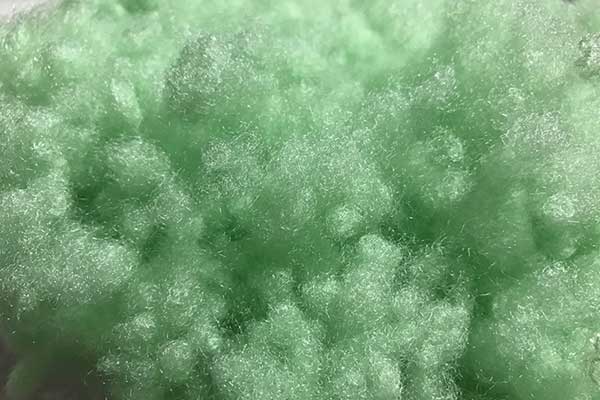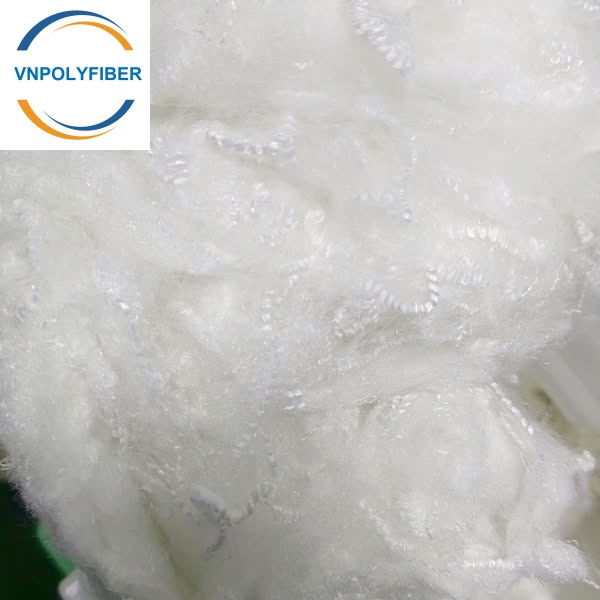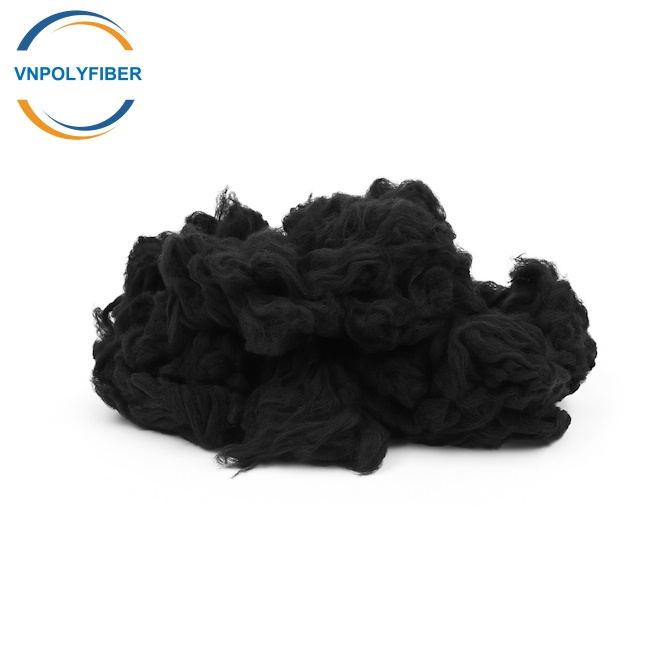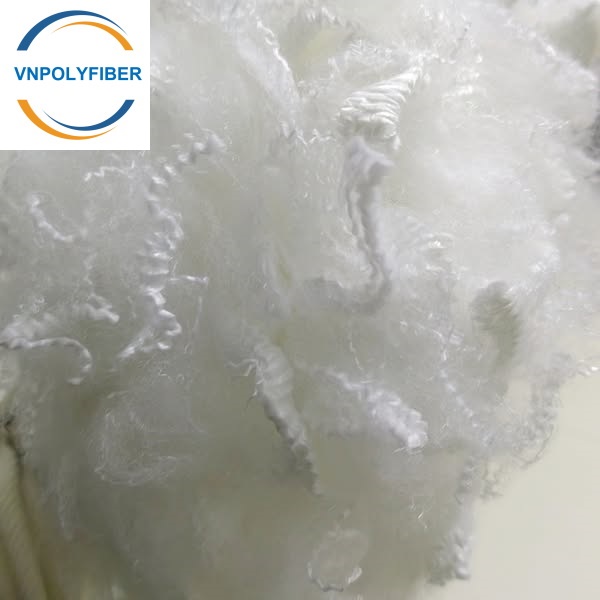Colored Nylon 6 Staple Fiber
- Nylon staple fiber for nonwoven applications is a high-denier fiber well-suited for various bonding methods such as thermal bonding, needle punching, chemical bonding, and spunlace.
- Common fiber specifications include 1.5D38mm, 2D51mm, 2.5D51mm, and 3D64mm, among others.
- Its non-toxic nature, lightweight, strong mechanical properties, wear resistance, and excellent corrosion resistance make polyamide an increasingly popular alternative to copper and other metals in manufacturing components like bearings, gears, and pump blades.
PRODUCT DETAIL
What is Nylon 6 Staple Fiber?
Nylon 6 staple fiber is a synthetic fiber made from Nylon 6 polymer, also known as polycaprolactam. It is cut into short, discrete lengths known as “staple” for use in textiles, nonwovens, and industrial applications. Nylon 6 is known for its excellent mechanical properties, durability, and versatility.
Key Features of Nylon 6 Staple Fiber
- Strength and Durability: Nylon 6 fibers are highly resistant to wear, tear, and abrasion, making them ideal for applications where durability is crucial, such as in carpets, upholstery, and industrial products.
- Elasticity: Nylon 6 staple fiber has excellent elasticity, allowing fabrics to stretch and recover, making it suitable for activewear, hosiery, and textiles requiring flexibility.
- Lightweight: Nylon 6 is a lightweight material, which helps reduce the overall weight of fabrics or products made from it, while still maintaining strength.
- Resistance to Chemicals and Corrosion: Nylon 6 fibers are resistant to many chemicals, oils, and fuels, as well as moisture and corrosion, making them suitable for industrial applications where exposure to harsh conditions is common.
- Moisture Management: While Nylon 6 absorbs some moisture (about 4-5%), it dries quickly, making it suitable for activewear and sports textiles.
- Heat Sensitivity: The melting point of Nylon 6 is around 215°C (419°F). This heat sensitivity needs to be considered during processing, but it also allows for applications like thermal bonding in nonwovens.
- Blending Capability: Nylon 6 staple fiber can be easily blended with other natural and synthetic fibers like cotton, polyester, and wool to enhance the overall properties of the fabric, such as adding strength, elasticity, or durability.
Common Specifications for Nylon 6 Staple Fiber
- Denier: 0.9 to 15 denier (depending on the end use).
- Cut Length: Common lengths include 38 mm, 51 mm, 64 mm, and 76 mm, but can vary depending on the application.
- Tenacity: 4.0 – 7.5 g/denier, providing excellent tensile strength.
Applications of Nylon 6 Staple Fiber
- Textiles:
- Apparel: Used in fabrics for sportswear, hosiery, and blended garments due to its stretch, durability, and quick-drying properties.
- Upholstery and Furnishings: Nylon 6 fibers are used in home textiles, furniture, and automotive interiors due to their resilience and resistance to wear.
- Nonwovens:
- Filtration Media: Nylon 6 staple fibers are used in nonwoven filters for their strength and durability in demanding conditions.
- Geotextiles: Utilized in geotextiles for civil engineering due to its ability to withstand harsh environments.
- Medical and Hygiene Products: Soft and non-toxic, making it suitable for disposable medical textiles and hygiene products.
- Industrial Applications:
- Carpet and Rugs: Nylon 6 staple fibers are widely used in carpets due to their high abrasion resistance and ability to retain color and texture over time.
- Automotive Components: The fiber’s mechanical strength and heat resistance make it a good choice for manufacturing car seat fabrics and industrial parts.
- Composites and Technical Fabrics: Nylon 6 staple fibers are also utilized in technical textiles and composite materials for industrial use, where strength, heat resistance, and chemical resistance are critical.
Benefits of Nylon 6 Staple Fiber
- Enhanced durability for heavy-duty applications.
- Excellent elasticity and recovery for fabrics requiring stretch.
- Resistant to environmental factors, such as moisture, chemicals, and abrasion.
- Lightweight yet strong, providing high-performance materials for a wide range of uses.
- Easy to dye and holds vibrant colors well, making it a great choice for fashion and interior fabrics.
Technical Parameter
- Fiber Type:
- Material: Made from Nylon 6 or Nylon 6,6 (Polyamide).
- Denier/Decitex (Fiber Thickness):
- Range: 0.9 to 15 Denier (1 to 16.7 dtex).
- Typical for Apparel: 1.5 to 6 denier.
- For Industrial Use: Up to 15 denier.
- Explanation: Denier measures the weight of 9,000 meters of fiber in grams. Lower values mean finer fibers, while higher values represent thicker, heavier fibers.
- Cut Length (Fiber Length):
- Range: 25 mm to 120 mm, depending on use.
- Common Lengths:
- For spinning: 38 mm, 51 mm, 64 mm.
- For nonwovens: 51 mm, 76 mm, 120 mm.
- Explanation: Refers to the length of individual fibers cut from continuous filament, usually measured in millimeters.
- Tenacity (Fiber Strength):
- Range: 4.0 to 7.5 g/denier (higher values for high-strength fibers).
- Explanation: Tenacity is the breaking strength of the fiber, given in grams per denier. Higher tenacity fibers are essential for applications requiring strong, durable materials like industrial textiles.
- Elongation (Stretch and Flexibility):
- Range: 18% to 40%.
- Typical Values:
- For apparel: 25% to 35%.
- For industrial applications: Generally lower elongation is preferred.
- Explanation: Elongation is the percentage the fiber stretches before breaking. Higher elongation implies better elasticity, which is important in clothing and upholstery.
- Moisture Absorption:
- Range: 4.0% to 4.5% at 65% relative humidity.
- Explanation: Nylon fibers can absorb moisture from the air, making garments more comfortable, yet they dry faster compared to natural fibers like cotton.
- Melting Point:
- Nylon 6: Approximately 215°C (419°F).
- Nylon 6,6: Around 250°C (482°F).
- Explanation: This is the temperature at which the fiber starts to melt, important for handling heat during processing.
- Specific Gravity:
- Value: 1.14 g/cm³.
- Explanation: This measures the fiber’s density compared to water, affecting how heavy or light the fabric feels.
- Crimp (Fiber Structure):
- Crimp Frequency: 8 to 14 crimps per inch (CPI) for clothing applications.
- Crimp Types: Textured, flat, or latent, depending on the intended use (e.g., for textiles or industrial products).
- Explanation: Crimping adds waves or curls to the fiber, increasing bulk, elasticity, and enhancing spinning and fabric loft.
- Color:
- Options: Available in raw white, black, or solution-dyed.
- Solution Dyeing: Dyes are applied during the fiber extrusion process, offering improved colorfastness and UV resistance.
- Explanation: Nylon fibers can be dyed after production or during manufacturing, depending on the intended color needs.
- Luster:
- Options: Available in bright, semi-dull, or dull finishes.
- Explanation: Luster refers to the fiber’s shine. It can be controlled to achieve either a matte or glossy appearance in the final product.
- Thermal Shrinkage:
- Range: 1.0% to 3.0% at 100°C.
- Explanation: This measures how much the fiber shrinks when exposed to heat, important for high-temperature processes like heat setting.
- Spinnability:
- Properties: Excellent spinning performance in both ring and open-end spinning, with good fiber cohesion.
- Blending: Can be mixed with cotton, wool, polyester, and other fibers to create fabrics with diverse properties such as stretch and softness.
Video
FAQ
1. What do you offer?
We produce recycled hollow conjugated siliconized and non-siliconized polyester staple fiber mainly.
We also supply home textile machineries and products at factory origin and its price.
2. What is it used for?
Our fiber is widely used in filling, non-woven fabric, spinning, bedding stuff, home textile, automotive interiors…
3. Are you a factory or a trading company?
We are a factory specialized in polyester staple fiber for many years but now we also have our own professional trading company. We will source many types of textile products such as yarn, PP fibers from others to supply our own customers as well. We also provide our own customers with other related products such as: Foam, Pillows, Cushions, Toys, Down/ Feather,…
4. Where is your factory location?
Our factory locates in the north and the south of Vietnam. You can visit us from Ho Chi Minh City and Hanoi City, Vietnam. You could contact our salesman to fetch you if visiting.
5. Can you accept free sample?
Yes, the hand sample is free when not exceed 1 kilograms. Upon price confirmation, we will provide a sample within 2-3 days; the freight cost will be charged to client.
6. Can you provide ODM service?
Yes, we work on ODM orders. Which means size, material, quantity, design, packing solution, etc, will depend on your requests, and your logo will be customized on our products.
7. How about your quality? What’s the minimum order Quantity (MOQ)?
Please try a trial order, you will know it. The MOQ is 23,000 Kilograms/order, but the price will be lower if you order bulk volume.
8. Can I mix different items in one order?
Sure, you can mix any products we can provide.
9. How can you guarantee the product quality?
We have experienced QC team. We control not only productive process but also raw material. In addition, we have different kinds of testing instrument to help us guarantee the product quality.
10. What’s the payment terms?
L/C at sight, 30% TT in advance are mostly accepted; other terms shall be negotiable by both sides
For more information, please feel free to contact :
Mr. Tony Tan
Mobile number: +84 90 466 5251 (Whatsapp/Wechat/Viber/Signal)







